Episode 1 : Execution Context
-
Everything in JS happens inside the execution context. Imagine a sealed-off container inside which JS runs. It is an abstract concept that hold info about the env. within the current code is being executed.
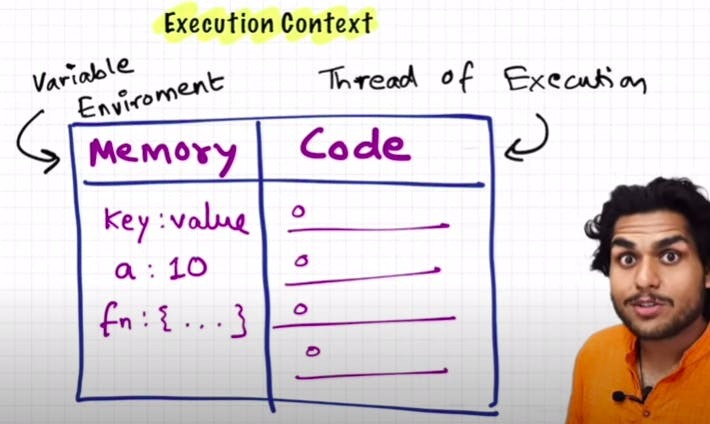
-
In the container the first component is memory component and the 2nd one is code component
-
Memory component has all the variables and functions in key value pairs. It is also called Variable environment.
-
Code component is the place where code is executed one line at a time. It is also called the Thread of Execution.
-
JS is a synchronous, single-threaded language
- Synchronous:- In a specific synchronous order.
- Single-threaded:- One command at a time.
Watch Live On Youtube below:
Episode 2 : How JS is executed & Call Stack
-
When a JS program is ran, a global execution context is created.
-
The execution context is created in two phases.
- Memory creation phase - JS will allocate memory to variables and functions.
- Code execution phase
-
Let's consider the below example and its code execution steps:
var n = 2;
function square(num) {
var ans = num * num;
return ans;
}
var square2 = square(n);
var square4 = square(4);
The very first thing which JS does is memory creation phase, so it goes to line one of above code snippet, and allocates a memory space for variable 'n' and then goes to line two, and allocates a memory space for function 'square'. When allocating memory for n it stores 'undefined', a special value for 'n'. For 'square', it stores the whole code of the function inside its memory space. Then, as square2 and square4 are variables as well, it allocates memory and stores 'undefined' for them, and this is the end of first phase i.e. memory creation phase.
So O/P will look something like

Now, in 2nd phase i.e. code execution phase, it starts going through the whole code line by line. As it encounters var n = 2, it assigns 2 to 'n'. Until now, the value of 'n' was undefined. For function, there is nothing to execute. As these lines were already dealt with in memory creation phase.
Coming to line 6 i.e. var square2 = square(n), here functions are a bit different than any other language. A new execution context is created altogether. Again in this new execution context, in memory creation phase, we allocate memory to num and ans the two variables. And undefined is placed in them. Now, in code execution phase of this execution context, first 2 is assigned to num. Then var ans = num * num will store 4 in ans. After that, return ans returns the control of program back to where this function was invoked from.
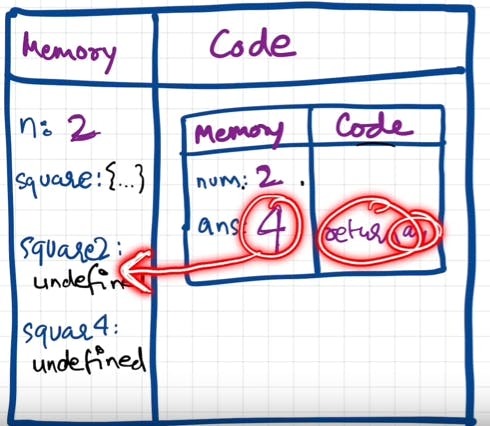
When return keyword is encountered, It returns the control to the called line and also the function execution context is deleted. Same thing will be repeated for square4 and then after that is finished, the global execution context will be destroyed. So the final diagram before deletion would look something like:
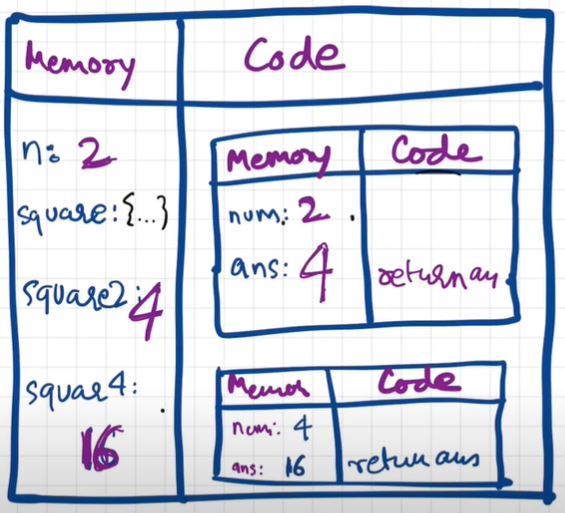
-
Javascript manages code execution context creation and deletion with the the help of Call Stack.
-
Call Stack is a mechanism to keep track of its place in script that calls multiple function.
-
Call Stack maintains the order of execution of execution contexts. It is also known as Program Stack, Control Stack, Runtime stack, Machine Stack, Execution context stack.
Watch Live On Youtube below:
Episode 3 : Hoisting in JavaScript (variables & functions)
- Let's observe the below code and it's explaination:
getName(); // Namaste Javascript
console.log(x); // undefined
var x = 7;
function getName() {
console.log("Namaste Javascript");
}
-
It should have been an outright error in many other languages, as it is not possible to even access something which is not even created (defined) yet But in JS, We know that in memory creation phase it assigns undefined and puts the content of function to function's memory. And in execution, it then executes whatever is asked. Here, as execution goes line by line and not after compiling, it could only print undefined and nothing else. This phenomenon, is not an error. However, if we remove var x = 7; then it gives error. Uncaught ReferenceError: x is not defined
-
Hoisting is a concept which enables us to extract values of variables and functions even before initialising/assigning value without getting error and this is happening due to the 1st phase (memory creation phase) of the Execution Context.
-
So in previous lecture, we learnt that execution context gets created in two phase, so even before code execution, memory is created so in case of variable, it will be initialized as undefined while in case of function the whole function code is placed in the memory. Example:
getName(); // Namaste JavaScript
console.log(x); // Uncaught Reference: x is not defined.
console.log(getName); // f getName(){ console.log("Namaste JavaScript); }
function getName(){
console.log("Namaste JavaScript");
}
- Now let's observe a different example and try to understand the output.
getName(); // Uncaught TypeError: getName is not a function
console.log(getName);
var getName = function () {
console.log("Namaste JavaScript");
}
// The code won't execute as the first line itself throws an TypeError.
Watch Live On Youtube below:
Episode 4 : Functions and Variable Environments
var x = 1;
a();
b(); // we are calling the functions before defining them. This will work properly, as seen in Hoisting.
console.log(x); // 3
function a() {
var x = 10; // localscope because of separate execution context
console.log(x); // 1
}
function b() {
var x = 100;
console.log(x); // 2
}
Outputs:
10
100
1
Code Flow in terms of Execution Context
- The Global Execution Context (GEC) is created (the big box with Memory and Code subparts). Also GEC is pushed into Call Stack
Call Stack : GEC
-
In first phase of GEC (memory phase), variable x:undefined and a and b have their entire function code as value initialized
-
In second phase of GEC (execution phase), when the function is called, a new local Execution Context is created. After x = 1 assigned to GEC x, a() is called. So local EC for a is made inside code part of GEC.
Call Stack: [GEC, a()]
- For local EC, a totally different x variable assigned undefined(x inside a()) in phase 1 , and in phase 2 it is assigned 10 and printed in console log. After printing, no more commands to run, so a() local EC is removed from both GEC and from Call stack
Call Stack: GEC
- Cursor goes back to b() function call. Same steps repeat.
Call Stack :[GEC, b()] -> GEC (after printing yet another totally different x value as 100 in console log)
-
Finally GEC is deleted and also removed from call stack. Program ends.
-
reference:

Watch Live On Youtube below:
Episode 5 : Shortest JS Program, window & this keyword
-
The shortest JS program is empty file. Because even then, JS engine does a lot of things. As always, even in this case, it creates the GEC which has memory space and the execution context.
-
JS engine creates something known as 'window'. It is an object, which is created in the global space. It contains lots of functions and variables. These functions and variables can be accessed from anywhere in the program. JS engine also creates a this keyword, which points to the window object at the global level. So, in summary, along with GEC, a global object (window) and a this variable are created.
-
In different engines, the name of global object changes. Window in browsers, but in nodeJS it is called something else. At global level, this === window
-
If we create any variable in the global scope, then the variables get attached to the global object.
eg:
var x = 10;
console.log(x); // 10
console.log(this.x); // 10
console.log(window.x); // 10
Watch Live On Youtube below:
Episode 6 : undefined vs not defined in JS
-
In first phase (memory allocation) JS assigns each variable a placeholder called undefined.
-
undefined is when memory is allocated for the variable, but no value is assigned yet.
-
If an object/variable is not even declared/found in memory allocation phase, and tried to access it then it is Not defined
-
Not Defined !== Undefined
When variable is declared but not assigned value, its current value is undefined. But when the variable itself is not declared but called in code, then it is not defined.
console.log(x); // undefined
var x = 25;
console.log(x); // 25
console.log(a); // Uncaught ReferenceError: a is not defined
- JS is a loosely typed / weakly typed language. It doesn't attach variables to any datatype. We can say var a = 5, and then change the value to boolean a = true or string a = 'hello' later on.
- Never assign undefined to a variable manually. Let it happen on it's own accord.
Watch Live On Youtube below:
Episode 7 : The Scope Chain, Scope & Lexical Environment
-
Scope in Javascript is directly related to Lexical Environment.
-
Let's observe the below examples:
// CASE 1
function a() {
console.log(b); // 10
// Instead of printing undefined it prints 10, So somehow this a function could access the variable b outside the function scope.
}
var b = 10;
a();
// CASE 2
function a() {
c();
function c() {
console.log(b); // 10
}
}
var b = 10;
a();
// CASE 3
function a() {
c();
function c() {
var b = 100;
console.log(b); // 100
}
}
var b = 10;
a();
// CASE 4
function a() {
var b = 10;
c();
function c() {
console.log(b); // 10
}
}
a();
console.log(b); // Error, Not Defined
- Let's try to understand the output in each of the cases above.
-
In case 1: function a is able to access variable b from Global scope.
-
In case 2: 10 is printed. It means that within nested function too, the global scope variable can be accessed.
-
In case 3: 100 is printed meaning local variable of the same name took precedence over a global variable.
-
In case 4: A function can access a global variable, but the global execution context can't access any local variable.
To summarize the above points in terms of execution context: call_stack = [GEC, a(), c()] Now lets also assign the memory sections of each execution context in call_stack. c() = [[lexical environment pointer pointing to a()]] a() = [b:10, c:{}, [lexical environment pointer pointing to GEC]] GEC = [a:{},[lexical_environment pointer pointing to null]]

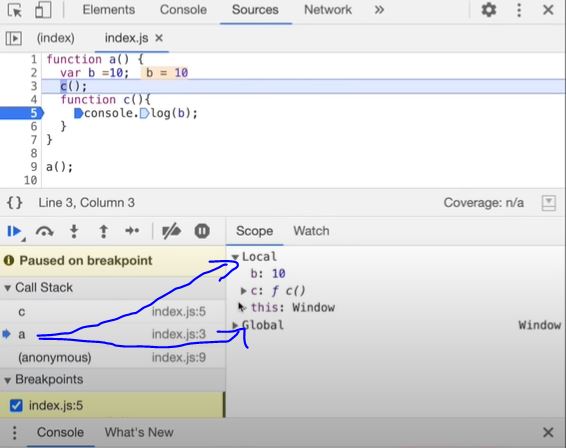
-
-
So, Lexical Environment = local memory + lexical env of its parent. Hence, Lexical Environement is the local memory along with the lexical environment of its parent
-
Lexical: In hierarchy, In order
-
Whenever an Execution Context is created, a Lexical environment(LE) is also created and is referenced in the local Execution Context(in memory space).
-
The process of going one by one to parent and checking for values is called scope chain or Lexcial environment chain.
-
function a() { function c() { // logic here } c(); // c is lexically inside a } // a is lexically inside global execution -
Lexical or Static scope refers to the accessibility of variables, functions and object based on phylical location in source code.
Global { Outer { Inner } } // Inner is surrounded by lexical scope of Outer -
TLDR; An inner function can access variables which are in outer functions even if inner function is nested deep. In any other case, a function can't access variables not in its scope.
Watch Live On Youtube below:
Episode 8 : let & const in JS, Temporal Dead Zone
- let and const declarations are hoisted. But its different from var
It looks like let isn't hoisted, but it is, let's understandconsole.log(a); // ReferenceError: Cannot access 'a' before initialization console.log(b); // prints undefined as expected let a = 10; console.log(a); // 10 var b = 15; console.log(window.a); // undefined console.log(window.b); // 15- Both a and b are actually initialized as undefined in hoisting stage. But var b is inside the storage space of GLOBAL, and a is in a separate memory object called script, where it can be accessed only after assigning some value to it first ie. one can access 'a' only if it is assigned. Thus, it throws error.
-
Temporal Dead Zone : Time since when the let variable was hoisted until it is initialized some value.
- So any line till before "let a = 10" is the TDZ for a
- Since a is not accessible on global, its not accessible in window/this also. window.b or this.b -> 15; But window.a or this.a ->undefined, just like window.x->undefined (x isn't declared anywhere)
-
Reference Error are thrown when variables are in temporal dead zone.
-
Syntax Error doesn't even let us run single line of code.
-
let a = 10; let a = 100; //this code is rejected upfront as SyntaxError. (duplicate declaration) ------------------ let a = 10; var a = 100; // this code also rejected upfront as SyntaxError. (can't use same name in same scope)
-
-
Let is a stricter version of var. Now, const is even more stricter than let.
let a; a = 10; console.log(a) // 10. Note declaration and assigning of a is in different lines. ------------------ const b; b = 10; console.log(b); // SyntaxError: Missing initializer in const declaration. (This type of declaration won't work with const. const b = 10 only will work) ------------------ const b = 100; b = 1000; //this gives us TypeError: Assignment to constant variable. -
Types of Error: Syntax, Reference, and Type.
-
Uncaught ReferenceError: x is not defined at ...
- This Error signifies that x has never been in the scope of the program. This literally means that x was never defined/declared and is being tried to be accesed.
-
Uncaught ReferenceError: cannot access 'a' before initialization
- This Error signifies that 'a' cannot be accessed because it is declared as 'let' and since it is not assigned a value, it is its Temporal Dead Zone. Thus, this error occurs.
-
Uncaught SyntaxError: Identifier 'a' has already been declared
- This Error signifies that we are redeclaring a variable that is 'let' declared. No execution will take place.
-
Uncaught SyntaxError: Missing initializer in const declaration
- This Error signifies that we haven't initialized or assigned value to a const declaration.
-
Uncaught TypeError: Assignment to constant variable
- This Error signifies that we are reassigning to a const variable.
-
SOME GOOD PRACTICES:
- Try using const wherever possible.
- If not, use let, Avoid var.
- Declare and initialize all variables with let to the top to avoid errors to shrink temporal dead zone window to zero.
Watch Live On Youtube below:
Episode 9 : Block Scope & Shadowing in JS
What is a Block?
-
Block aka compound statement is used to group JS statements together into 1 group. We group them within {...}
{ var a = 10; let b = 20; const c = 30; // Here let and const are hoisted in Block scope, // While, var is hoisted in Global scope. } -
Block Scope and its accessibility example
{ var a = 10; let b = 20; const c = 30; } console.log(a); // 10 console.log(b); // Uncaught ReferenceError: b is not defined- Reason?
-
In the BLOCK SCOPE; we get b and c inside it initialized as undefined as a part of hoisting (in a seperate memory space called block)
-
While, a is stored inside a GLOBAL scope.
-
Thus we say, let and const are BLOCK SCOPED. They are stored in a separate mem space which is reserved for this block. Also, they can't be accessed outside this block. But var a can be accessed anywhere as it is in global scope. Thus, we can't access them outside the Block.
-
- Reason?
What is Shadowing?
-
var a = 100; { var a = 10; // same name as global var let b = 20; const c = 30; console.log(a); // 10 console.log(b); // 20 console.log(c); // 30 } console.log(a); // 10, instead of the 100 we were expecting. So block "a" modified val of global "a" as well. In console, only b and c are in block space. a initially is in global space(a = 100), and when a = 10 line is run, a is not created in block space, but replaces 100 with 10 in global space itself. -
So, If one has same named variable outside the block, the variable inside the block shadows the outside variable. This happens only for var
-
Let's observe the behaviour in case of let and const and understand it's reason.
let b = 100; { var a = 10; let b = 20; const c = 30; console.log(b); // 20 } console.log(b); // 100, Both b's are in separate spaces (one in Block(20) and one in Script(another arbitrary mem space)(100)). Same is also true for *const* declarations.
-
Same logic is true even for functions
const c = 100; function x() { const c = 10; console.log(c); // 10 } x(); console.log(c); // 100
What is Illegal Shadowing?
-
let a = 20; { var a = 20; } // Uncaught SyntaxError: Identifier 'a' has already been declared- We cannot shadow let with var. But it is valid to shadow a let using a let. However, we can shadow var with let.
- All scope rules that work in function are same in arrow functions too.
- Since var is function scoped, it is not a problem with the code below.
let a = 20; function x() { var a = 20; }
Watch Live On Youtube below:
Episode 10 : Closures in JS
-
Function bundled along with it's lexical scope is closure.
-
JavaScript has a lexcial scope environment. If a function needs to access a variable, it first goes to its local memory. When it does not find it there, it goes to the memory of its lexical parent. See Below code, Over here function y along with its lexical scope i.e. (function x) would be called a closure.
function x() { var a = 7; function y() { console.log(a); } return y; } var z = x(); console.log(z); // value of z is entire code of function y.- In above code, When y is returned, not only is the function returned but the entire closure (fun y + its lexical scope) is returned and put inside z. So when z is used somewhere else in program, it still remembers var a inside x()
-
Another Example
function z() {
var b = 900;
function x() {
var a=7;
function y(){
console.log(a,b);
}
y();
}
x();
}
z(); // 7 900
- Thus In simple words, we can say:
- A closure is a function that has access to its outer function scope even after the function has returned. Meaning, A closure can remember and access variables and arguments reference of its outer function even after the function has returned.
-
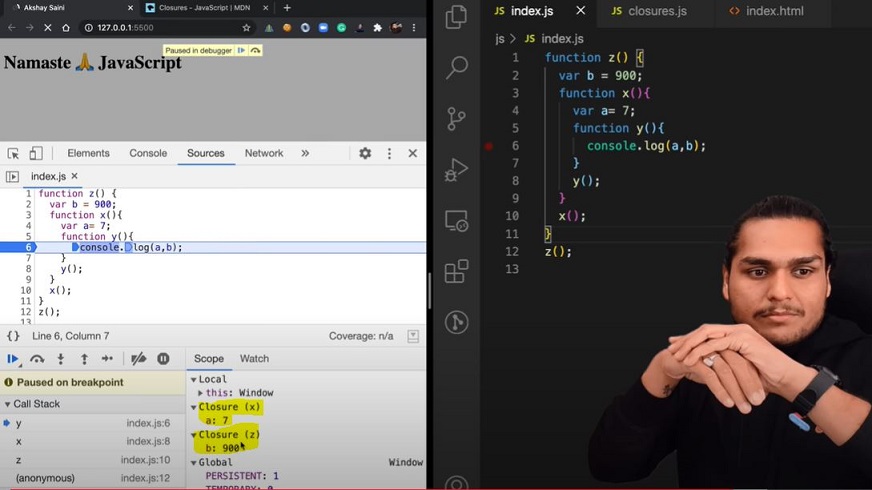
-
Advantages of Closure:
- Module Design Pattern
- Currying
- Memoize
- Data hiding and encapsulation
- setTimeouts etc.
-
Disadvantages of Closure:
- Over consumption of memory
- Memory Leak
- Freeze browser
Watch Live On Youtube below:
Episode 11 : setTimeout + Closures Interview Question
Time, tide and Javascript wait for none.
-
function x() { var i = 1; setTimeout(function() { console.log(i); }, 3000); console.log("Namaste Javascript"); } x(); // Output: // Namaste Javascript // 1 // after waiting 3 seconds- We expect JS to wait 3 sec, print 1 and then go down and print the string. But JS prints string immediately, waits 3 sec and then prints 1.
- The function inside setTimeout forms a closure (remembers reference to i). So wherever function goes it carries this ref along with it.
- setTimeout takes this callback function & attaches timer of 3000ms and stores it. Goes to next line without waiting and prints string.
- After 3000ms runs out, JS takes function, puts it into call stack and runs it.
-
Q: Print 1 after 1 sec, 2 after 2 sec till 5 : Tricky interview question
We assume this has a simple approach as below
function x() { for(var i = 1; i<=5; i++){ setTimeout(function() { console.log(i); }, i*1000); } console.log("Namaste Javascript"); } x(); // Output: // Namaste Javascript // 6 // 6 // 6 // 6 // 6-
Reason?
-
This happens because of closures. When setTimeout stores the function somewhere and attaches timer to it, the function remembers its reference to i, not value of i. All 5 copies of function point to same reference of i. JS stores these 5 functions, prints string and then comes back to the functions. By then the timer has run fully. And due to looping, the i value became 6. And when the callback fun runs the variable i = 6. So same 6 is printed in each log
-
To avoid this, we can use let instead of var as let has Block scope. For each iteration, the i is a new variable altogether(new copy of i). Everytime setTimeout is run, the inside function forms closure with new variable i
-
-
But what if interviewer ask us to implement using var?
function x() { for(var i = 1; i<=5; i++){ function close(i) { setTimeout(function() { console.log(i); }, i*1000); // put the setT function inside new function close() } close(i); // everytime you call close(i) it creates new copy of i. Only this time, it is with var itself! } console.log("Namaste Javascript"); } x();
-
Watch Live On Youtube below:
Episode 12 : Famous Interview Questions ft. Closures
Q1: What is Closure in Javascript?
Ans: A function along with reference to its outer environment together forms a closure. Or in other words, A Closure is a combination of a function and its lexical scope bundled together. eg:
function outer() {
var a = 10;
function inner() {
console.log(a);
} // inner forms a closure with outer
return inner;
}
outer()(); // 10 // over here first `()` will return inner function and then using secong `()` to call inner function
Q2: Will the below code still forms a closure?
function outer() {
function inner() {
console.log(a);
}
var a = 10;
return inner;
}
outer()(); // 10
Ans: Yes, because inner function forms a closure with its outer environment so sequence doesn't matter.
Q3: Changing var to let, will it make any difference?
function outer() {
let a = 10;
function inner() {
console.log(a);
}
return inner;
}
outer()(); // 10
Ans: It will still behave the same way.
Q4: Will inner function have the access to outer function argument?
function outer(str) {
let a = 10;
function inner() {
console.log(a, str);
}
return inner;
}
outer("Hello There")(); // 10 "Hello There"
Ans: Inner function will now form closure and will have access to both a and b.
Q5: In below code, will inner form closure with outest?
function outest() {
var c = 20;
function outer(str) {
let a = 10;
function inner() {
console.log(a, c, str);
}
return inner;
}
return outer;
}
outest()("Hello There")(); // 10 20 "Hello There"
Ans: Yes, inner will have access to all its outer environment.
Q6: Output of below code and explaination?
function outest() {
var c = 20;
function outer(str) {
let a = 10;
function inner() {
console.log(a, c, str);
}
return inner;
}
return outer;
}
let a = 100;
outest()("Hello There")(); // 10 20 "Hello There"
Ans: Still the same output, the inner function will have reference to inner a, so conflicting name won't matter here. If it wouldn't have find a inside outer function then it would have went more outer to find a and thus have printed 100. So, it try to resolve variable in scope chain and if a wouldn't have been found it would have given reference error.
Q7: Advantage of Closure?
- Module Design Pattern
- Currying
- Memoize
- Data hiding and encapsulation
- setTimeouts etc.
Q8: Discuss more on Data hiding and encapsulation?
// without closures
var count = 0;
function increment(){
count++;
}
// in the above code, anyone can access count and change it.
------------------------------------------------------------------
// (with closures) -> put everything into a function
function counter() {
var count = 0;
function increment(){
count++;
}
}
console.log(count); // this will give referenceError as count can't be accessed. So now we are able to achieve hiding of data
------------------------------------------------------------------
//(increment with function using closure) true function
function counter() {
var count = 0;
return function increment(){
count++;
console.log(count);
}
}
var counter1 = counter(); //counter function has closure with count var.
counter1(); // increments counter
var counter2 = counter();
counter2(); // here counter2 is whole new copy of counter function and it wont impack the output of counter1
*************************
// Above code is not good and scalable for say, when you plan to implement decrement counter at a later stage.
// To address this issue, we use *constructors*
// Adding decrement counter and refactoring code:
function Counter() {
//constructor function. Good coding would be to capitalize first letter of constructor function.
var count = 0;
this.incrementCounter = function() { //anonymous function
count++;
console.log(count);
}
this.decrementCounter = function() {
count--;
console.log(count);
}
}
var counter1 = new Counter(); // new keyword for constructor fun
counter1.incrementCounter();
counter1.incrementCounter();
counter1.decrementCounter();
// returns 1 2 1
Q9: Disadvantage of closure?
Ans: Overconsumption of memory when using closure as everytime as those closed over variables are not garbage collected till program expires. So when creating many closures, more memory is accumulated and this can create memory leaks if not handled.
Garbage collector : Program in JS engine or browser that frees up unused memory. In highlevel languages like C++ or JAVA, garbage collection is left to the programmer, but in JS engine its done implicitly.
function a() {
var x = 0;
return function b() {
console.log(x);
}
}
var y = a(); // y is a copy of b()
y();
// Once a() is called, its element x should be garbage collected ideally. But fun b has closure over var x. So mem of x cannot be freed. Like this if more closures formed, it becomes an issue. To tacke this, JS engines like v8 and Chrome have smart garbage collection mechanisms. Say we have var x = 0, z = 10 in above code. When console log happens, x is printed as 0 but z is removed automatically.
Watch Live On Youtube below:
Episode 13 : First Class Functions ft. Anonymous Functions
Functions are heart ♥ of Javascript.
Q: What is Function statement?
Below way of creating function are function statement.
function a() {
console.log("Hello");
}
a(); // Hello
Q: What is Function Expression?
Assigning a function to a variable. Function acts like a value.
var b = function() {
console.log("Hello");
}
b();
Q: Difference between function statement and expression
The major difference between these two lies in Hoisting.
a(); // "Hello A"
b(); // TypeError
function a() {
console.log("Hello A");
}
var b = function() {
console.log("Hello B");
}
// Why? During mem creation phase a is created in memory and function assigned to a. But b is created like a variable (b:undefined) and until code reaches the function() part, it is still undefined. So it cannot be called.
Q: What is Function Declaration?
Other name for function statement.
Q: What is Anonymous Function?
A function without a name.
function () {
}// this is going to throw Syntax Error - Function Statement requires function name.
- They don't have their own identity. So an anonymous function without code inside it results in an error.
- Anonymous functions are used when functions are used as values eg. the code sample for function expression above.
Q: What is Named Function Expression?
Same as Function Expression but function has a name instead of being anonymous.
var b = function xyz() {
console.log("b called");
}
b(); // "b called"
xyz(); // Throws ReferenceError:xyz is not defined.
// xyz function is not created in global scope. So it can't be called.
Q: Parameters vs Arguments?
var b = function(param1, param2) { // labels/identifiers are parameters
console.log("b called");
}
b(arg1, arg2); // arguments - values passed inside function call
Q: What is First Class Function aka First Class Citizens?
We can pass functions inside a function as arguments and /or return a function(HOF). These ability are altogether known as First class function. It is programming concept available in some other languages too.
var b = function(param1) {
console.log(param1); // prints " f() {} "
}
b(function(){});
// Other way of doing the same thing:
var b = function(param1) {
console.log(param1);
}
function xyz(){
}
b(xyz); // same thing as prev code
// we can return a function from a function:
var b = function(param1) {
return function() {
}
}
console.log(b()); //we log the entire fun within b.
Watch Live On Youtube below:
Episode 14 : Callback Functions in JS ft. Event Listeners
Callback Functions
- Functions are first class citizens ie. take a function A and pass it to another function B. Here, A is a callback function. So basically I am giving access to function B to call function A. This callback function gives us the access to whole Asynchronous world in Synchronous world.
setTimeout(function () {
console.log("Timer");
}, 1000) // first argument is callback function and second is timer.
-
JS is a synchronous and single threaded language. But due to callbacks, we can do async things in JS.
-
setTimeout(function () { console.log("timer"); }, 5000); function x(y) { console.log("x"); y(); } x(function y() { console.log("y"); }); // x y timer- In the call stack, first x and y are present. After code execution, they go away and stack is empty. Then after 5 seconds (from beginning) anonymous suddenly appear up in stack ie. setTimeout
- All 3 functions are executed through call stack. If any operation blocks the call stack, its called blocking the main thread.
- Say if x() takes 30 sec to run, then JS has to wait for it to finish as it has only 1 call stack/1 main thread. Never block main thread.
- Always use async for functions that take time eg. setTimeout
-
// Another Example of callback function printStr(str, cb) { setTimeout(() => { console.log(str); cb(); }, Math.floor(Math.random() * 100) + 1) } function printAll() { printStr("A", () => { printStr("B", () => { printStr("C", () => {}) }) }) } printAll() // A B C // in order
Event Listener
- We will create a button in html and attach event to it.
// index.html <button id="clickMe">Click Me!</button> // in index.js document.getElementById("clickMe").addEventListener("click", function xyz(){ //when event click occurs, this callback function (xyz) is called into callstack console.log("Button clicked"); }); - Lets implement a increment counter button.
- Using global variable (not good as anyone can change it)
let count = 0; document.getElementById("clickMe").addEventListener("click", function xyz(){ console.log("Button clicked", ++count); }); - Use closures for data abstraction
function attachEventList() { //creating new function for closure let count = 0; document.getElementById("clickMe").addEventListener("click", function xyz(){ console.log("Button clicked", ++count); //now callback function forms closure with outer scope(count) }); } attachEventList();
- Using global variable (not good as anyone can change it)
Garbage Collection and removeEventListeners
- Event listeners are heavy as they form closures. So even when call stack is empty, EventListener won't free up memory allocated to count as it doesn't know when it may need count again. So we remove event listeners when we don't need them (garbage collected) onClick, onHover, onScroll all in a page can slow it down heavily.
Watch Live On Youtube below:
Episode 15 : Asynchronous JavaScript & EVENT LOOP from scratch
Note: Call stack will execeute any execeution context which enters it. Time, tide and JS waits for none. TLDR; Call stack has no timer.
- Browser has JS Engine which has Call Stack which has Global execution context, local execution context etc.
- But browser has many other superpowers - Local storage space, Timer, place to enter URL, Bluetooth access, Geolocation access and so on.
- Now JS needs some way to connect the callstack with all these superpowers. This is done using Web APIs.
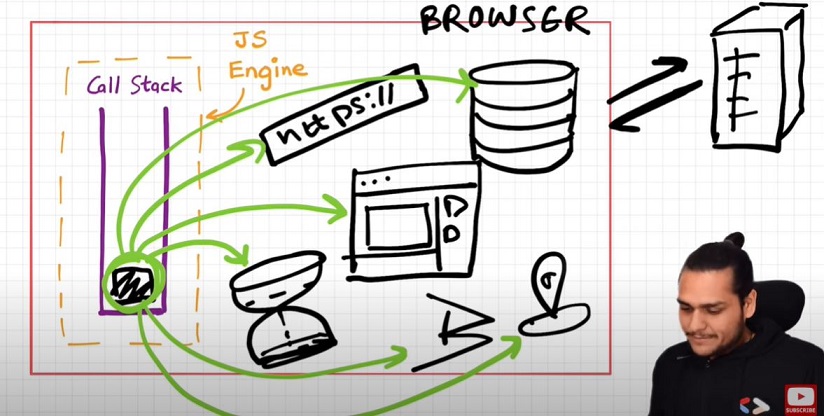
WebAPIs
None of the below are part of Javascript! These are extra superpowers that browser has. Browser gives access to JS callstack to use these powers.
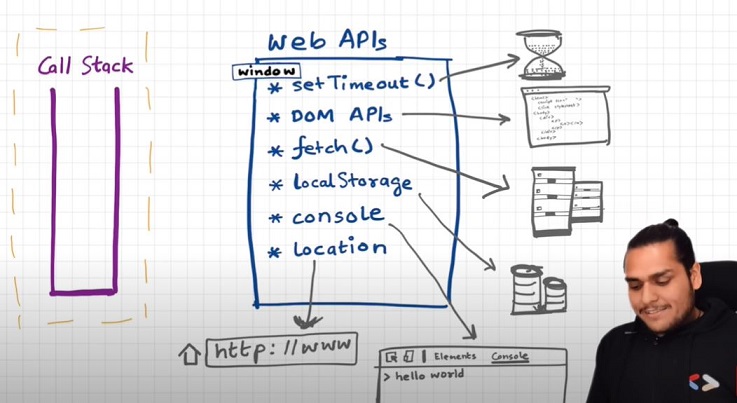
-
setTimeout(), DOM APIs, fetch(), localstorage, console (yes, even console.log is not JS!!), location and so many more.
- setTimeout() : Timer function
- DOM APIs : eg.Document.xxxx ; Used to access HTML DOM tree. (Document Object Manipulation)
- fetch() : Used to make connection with external servers eg. Netflix servers etc.
-
We get all these inside call stack through global object ie. window
- Use window keyword like : window.setTimeout(), window.localstorage, window.console.log() to log something inside console.
- As window is global obj, and all the above functions are present in global object, we don't explicity write window but it is implied.
-
Let's undertand the below code image and its explaination:
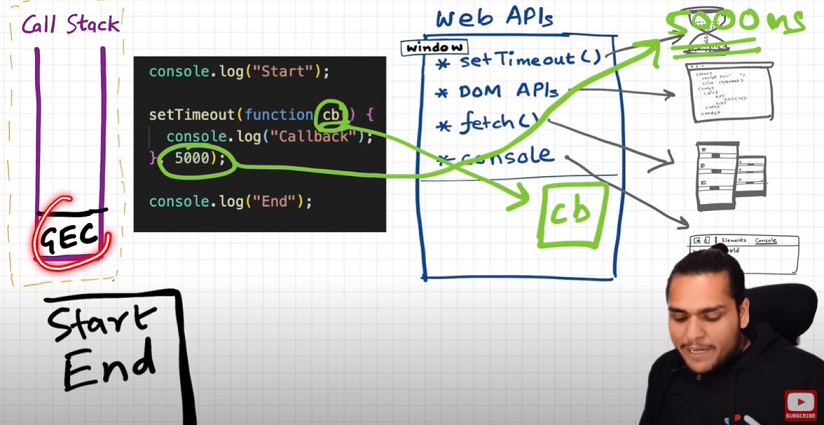
-
console.log("start"); setTimeout(function cb() { console.log("timer"); }, 5000); console.log("end"); // start end timer - First a GEC is created and put inside call stack.
- console.log("Start"); // this calls the console web api (through window) which in turn actually modifies values in console.
- setTimeout(function cb() { //this calls the setTimeout web api which gives access to timer feature. It stores the callback cb() and starts timer. console.log("Callback");}, 5000);
- console.log("End"); // calls console api and logs in console window. After this GEC pops from call stack.
- While all this is happening, the timer is constantly ticking. After it becomes 0, the callback cb() has to run.
- Now we need this cb to go into call stack. Only then will it be executed. For this we need event loop and Callback queue
-
Event Loops and Callback Queue
Q: How after 5 secs timer is console?
- cb() cannot simply directly go to callstack to be execeuted. It goes through the callback queue when timer expires.
- Event loop keep checking the callback queue, and see if it has any element to puts it into call stack. It is like a gate keeper.
- Once cb() is in callback queue, eventloop pushes it to callstack to run. Console API is used and log printed
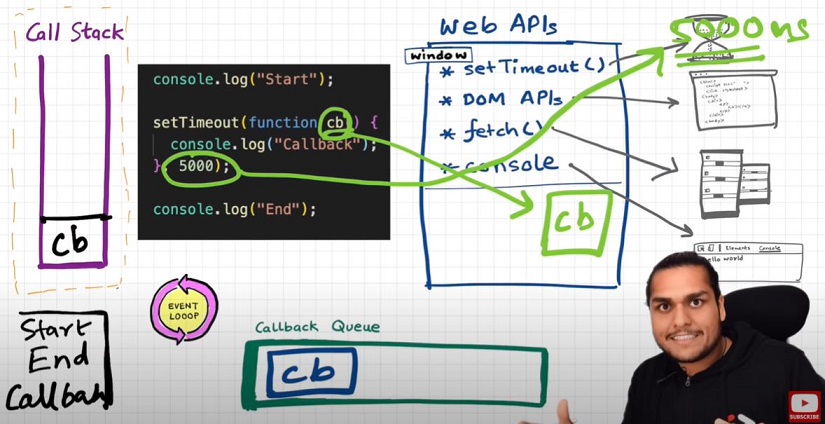
Q: Another example to understand Eventloop & Callback Queue.
See the below Image and code and try to understand the reason:
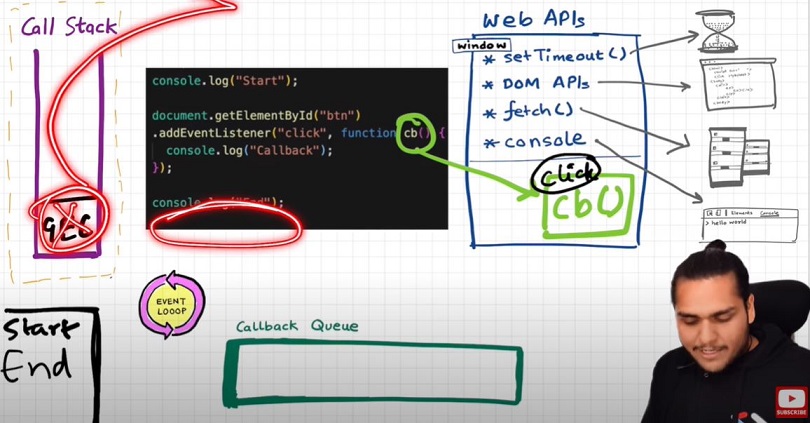 Explaination?
Explaination?
-
console.log("Start"); document. getElementById("btn").addEventListener("click", function cb() { // cb() registered inside webapi environment and event(click) attached to it. i.e. REGISTERING CALLBACK AND ATTACHING EVENT TO IT. console.log("Callback"); }); console.log("End"); // calls console api and logs in console window. After this GEC get removed from call stack. // In above code, even after console prints "Start" and "End" and pops GEC out, the eventListener stays in webapi env(with hope that user may click it some day) until explicitly removed, or the browser is closed. -
Eventloop has just one job to keep checking callback queue and if found something push it to call stack and delete from callback queue.
Q: Need of callback queue?
Ans: Suppose user clciks button x6 times. So 6 cb() are put inside callback queue. Event loop sees if call stack is empty/has space and whether callback queue is not empty(6 elements here). Elements of callback queue popped off, put in callstack, executed and then popped off from call stack.
Behaviour of fetch (Microtask Queue?)
Let's observe the code below and try to understand
console.log("Start"); // this calls the console web api (through window) which in turn actually modifies values in console.
setTimeout(function cbT() {
console.log("CB Timeout");
}, 5000);
fetch("https://api.netflix.com").then(function cbF() {
console.log("CB Netflix");
}); // take 2 seconds to bring response
// millions lines of code
console.log("End");
Code Explaination:
* Same steps for everything before fetch() in above code.
* fetch registers cbF into webapi environment along with existing cbT.
* cbT is waiting for 5000ms to end so that it can be put inside callback queue. cbF is waiting for data to be returned from Netflix servers gonna take 2 seconds.
* After this millions of lines of code is running, by the time millions line of code will execute, 5 seconds has finished and now the timer has expired and response from Netflix server is ready.
* Data back from cbF ready to be executed gets stored into something called a Microtask Queue.
* Also after expiration of timer, cbT is ready to execute in Callback Queue.
* Microtask Queue is exactly same as Callback Queue, but it has higher priority. Functions in Microtask Queue are executed earlier than Callback Queue.
* In console, first Start and End are printed in console. First cbF goes in callstack and "CB Netflix" is printed. cbF popped from callstack. Next cbT is removed from callback Queue, put in Call Stack, "CB Timeout" is printed, and cbT removed from callstack.
* See below Image for more understanding
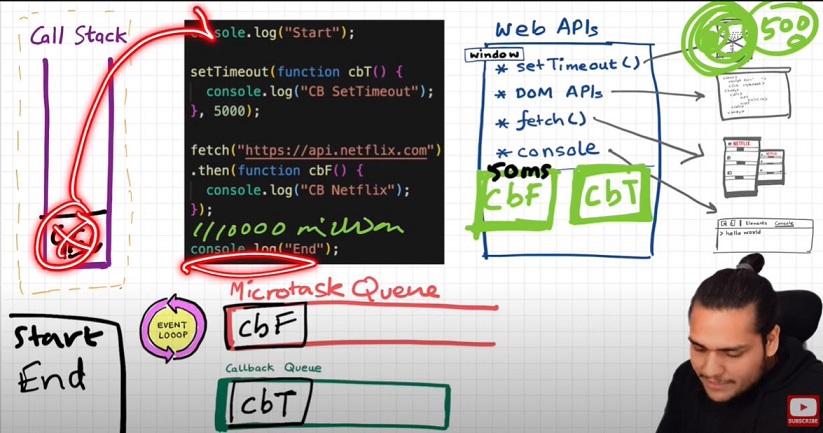 Microtask Priority Visualization
Microtask Priority Visualization
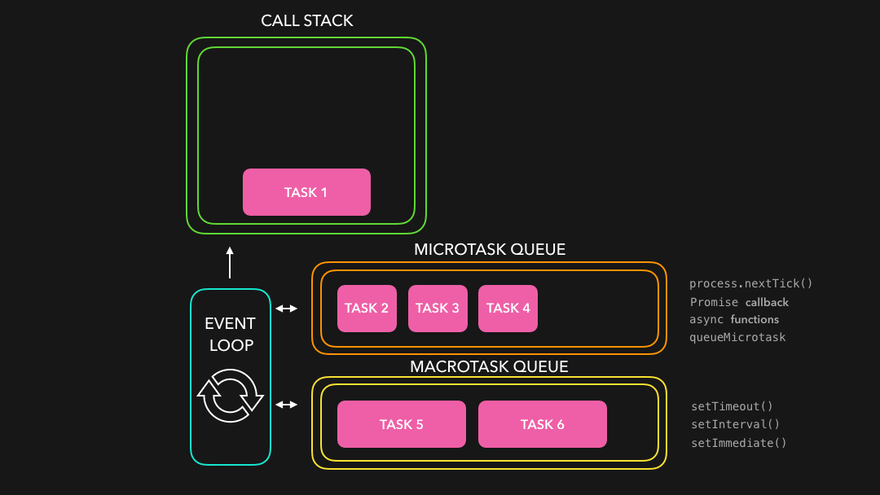
What enters the Microtask Queue ?
- All the callback functions that come through promises go in microtask Queue.
- Mutation Observer : Keeps on checking whether there is mutation in DOM tree or not, and if there, then it execeutes some callback function.
- Callback functions that come through promises and mutation observer go inside Microtask Queue.
- All the rest goes inside Callback Queue aka. Task Queue.
- If the task in microtask Queue keeps creating new tasks in the queue, element in callback queue never gets chance to be run. This is called starvation
Some Important Questions
-
When does the event loop actually start ? - Event loop, as the name suggests, is a single-thread, loop that is almost infinite. It's always running and doing its job.
-
Are only asynchronous web api callbacks are registered in web api environment? - YES, the synchronous callback functions like what we pass inside map, filter and reduce aren't registered in the Web API environment. It's just those async callback functions which go through all this.
-
Does the web API environment stores only the callback function and pushes the same callback to queue/microtask queue? - Yes, the callback functions are stored, and a reference is scheduled in the queues. Moreover, in the case of event listeners(for example click handlers), the original callbacks stay in the web API environment forever, that's why it's adviced to explicitly remove the listeners when not in use so that the garbage collector does its job.
-
How does it matter if we delay for setTimeout would be 0ms. Then callback will move to queue without any wait ? - No, there are trust issues with setTimeout() 😅. The callback function needs to wait until the Call Stack is empty. So the 0 ms callback might have to wait for 100ms also if the stack is busy.
Observation of Eventloop, Callback Queue & Microtask Queue [GiF]
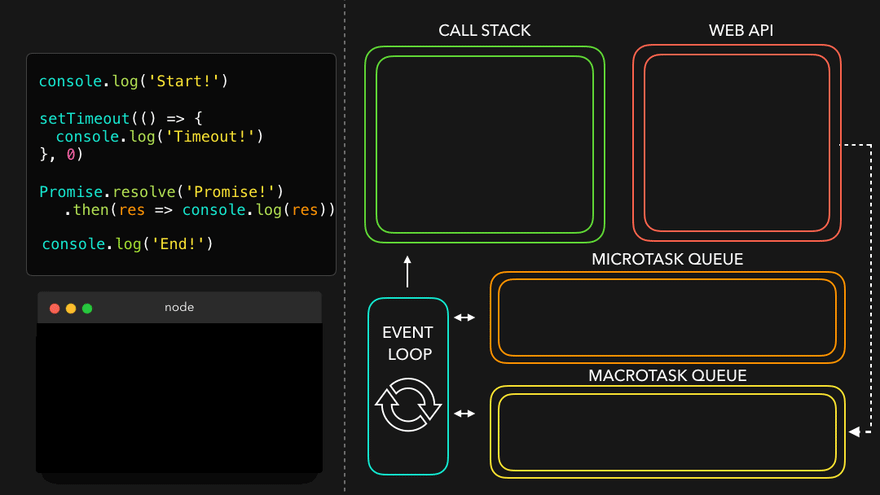
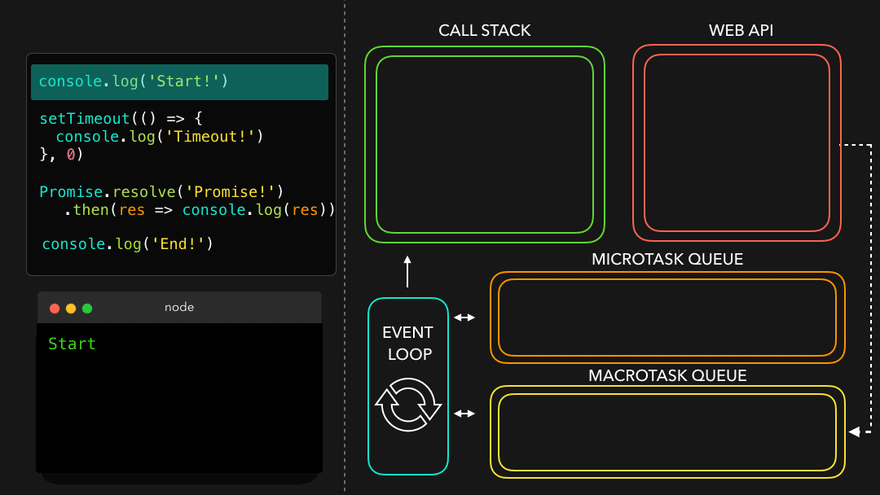
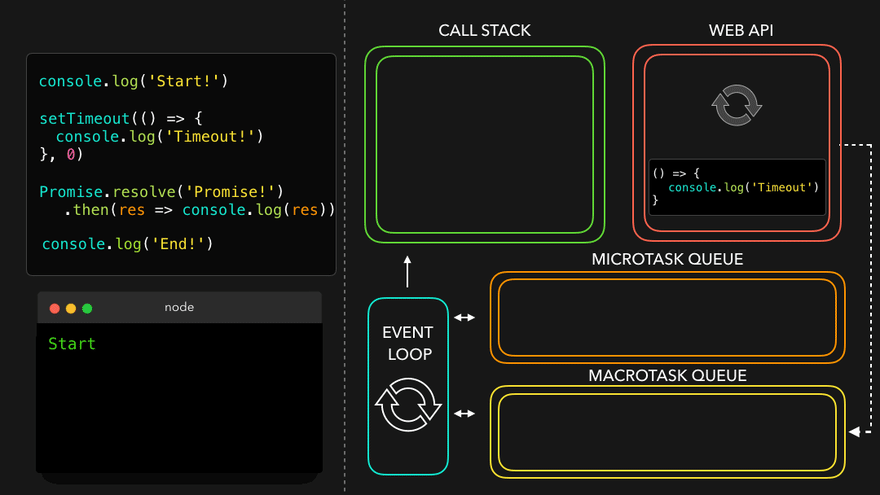
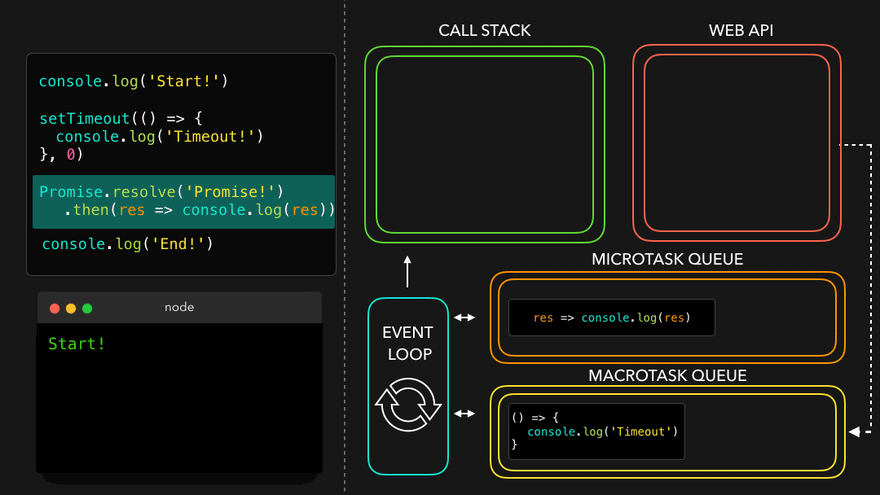
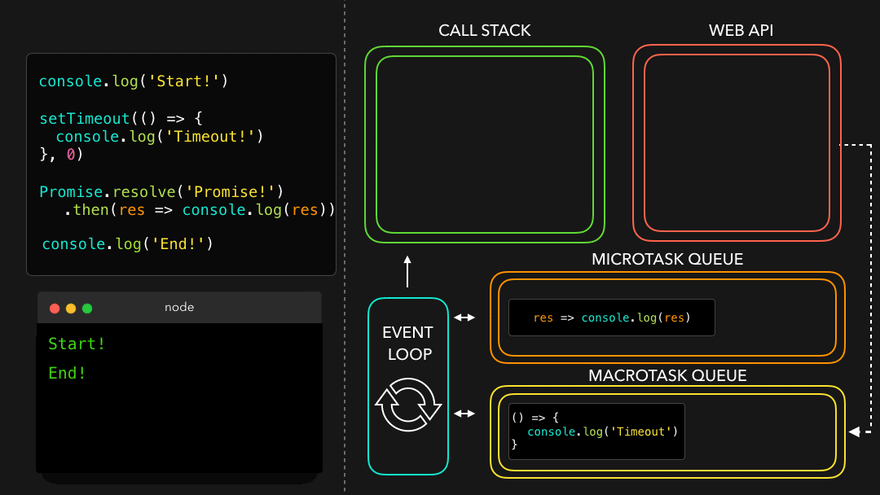
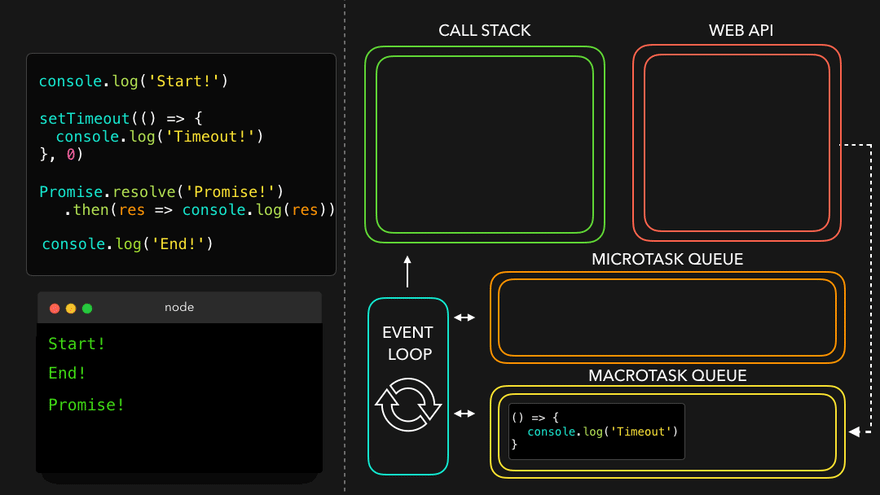
Watch Live On Youtube below:
Episode 16 : JS Engine Exposed, Google's V8 Architecture
-
JS runs literally everywhere from smart watch to robots to browsers because of Javascript Runtime Environment (JRE).
-
JRE is like a big container which has everything which are required to run Javascript code.
-
JRE consists of a JS Engine (❤️ of JRE), set of APIs to connect with outside environment, event loop, Callback queue, Microtask queue etc.
-
Browser can execute javascript code because it has the Javascript Runtime Environment.
-
ECMAScript is a governing body of JS. It has set of rules which are followed by all JS engines like Chakra(Edge), Spidermonkey(Firefox)(first javascript engine created by JS creator himself), v8(Chrome)
-
Javascript Engine is not a machine. Its software written in low level languages (eg. C++) that takes in hi-level code in JS and spits out low level machine code.
-
Code inside Javascript Engine passes through 3 steps : Parsing, Compilation and Execution
- Parsing - Code is broken down into tokens. In "let a = 7" -> let, a, =, 7 are all tokens. Also we have a syntax parser that takes code and converts it into an AST (Abstract Syntax Tree) which is a JSON with all key values like type, start, end, body etc (looks like package.json but for a line of code in JS. Kinda unimportant)(Check out astexplorer.net -> converts line of code into AST).
- Compilation - JS has something called Just-in-time(JIT) Compilation - uses both interpreter & compiler. Also compilation and execution both go hand in hand. The AST from previous step goes to interpreter which converts hi-level code to byte code and moves to execeution. While interpreting, compiler also works hand in hand to compile and form optimized code during runtime. Does JavaScript really Compiles? The answer is a loud YES. More info at: Link 1, Link 2, Link 3. JS used to be only interpreter in old times, but now has both to compile and interpreter code and this make JS a JIT compiled language, its like best of both world.
- Execution - Needs 2 components ie. Memory heap(place where all memory is stored) and Call Stack(same call stack from prev episodes). There is also a garbage collector. It uses an algo called Mark and Sweep.
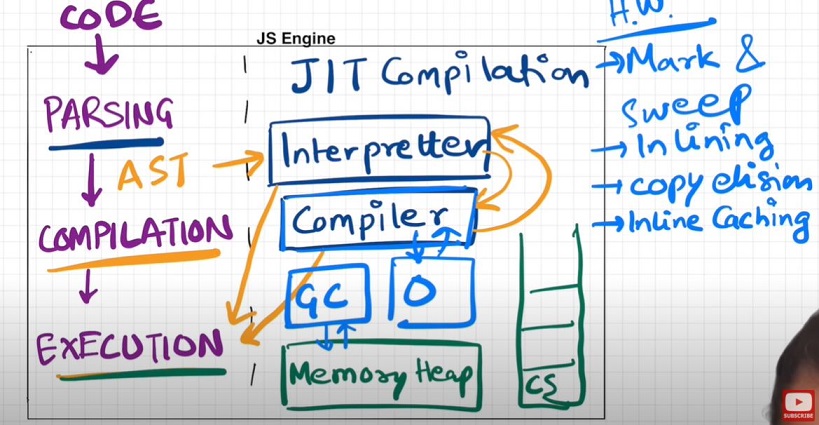 GiF Demo
GiF Demo

-
Companies use different JS engines and each try to make theirs the best.
- v8 of Google has Interpreter called Ignition, a compiler called Turbo Fan and garbage collector called Orinoco
- v8 architecture:
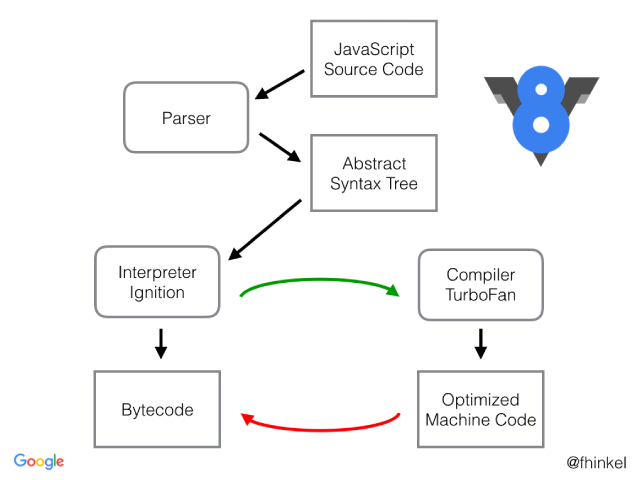
Watch Live On Youtube below:
Episode 17 : Trust issues with setTimeout()
-
setTimeout with timer of 5 secs sometimes does not exactly guarantees that the callback function will execute exactly after 5s.
-
Let's observe the below code and it's explaination
console.log("Start"); setTimeout(function cb() { console.log("Callback"); }, 5000); console.log("End"); // Millions of lines of code to execute // o/p: Over here setTimeout exactly doesn't guarantee that the callback function will be called exactly after 5s. Maybe 6,7 or even 10! It all depends on callstack. Why?Reason?
- First GEC is created and pushed in callstack.
- Start is printed in console
- When setTimeout is seen, callback function is registered into webapi's env. And timer is attached to it and started. callback waits for its turn to be execeuted once timer expires. But JS waits for none. Goes to next line.
- End is printed in console.
- After "End", we have 1 million lines of code that takes 10 sec(say) to finish execution. So GEC won't pop out of stack. It runs all the code for 10 sec.
- But in the background, the timer runs for 5s. While callstack runs the 1M line of code, this timer has already expired and callback fun has been pushed to Callback queue and waiting to pushed to callstack to get executed.
- Event loop keeps checking if callstack is empty or not. But here GEC is still in stack so cb can't be popped from callback Queue and pushed to CallStack. Though setTimeout is only for 5s, it waits for 10s until callstack is empty before it can execute (When GEC popped after 10sec, callstack() is pushed into call stack and immediately executed (Whatever is pushed to callstack is executed instantly).
- This is called as the Concurrency model of JS. This is the logic behind setTimeout's trust issues.
-
The First rule of JavaScript: Do not block the main thread (as JS is a single threaded(only 1 callstack) language).
-
In below example, we are blocking the main thread. Observe Questiona and Output.
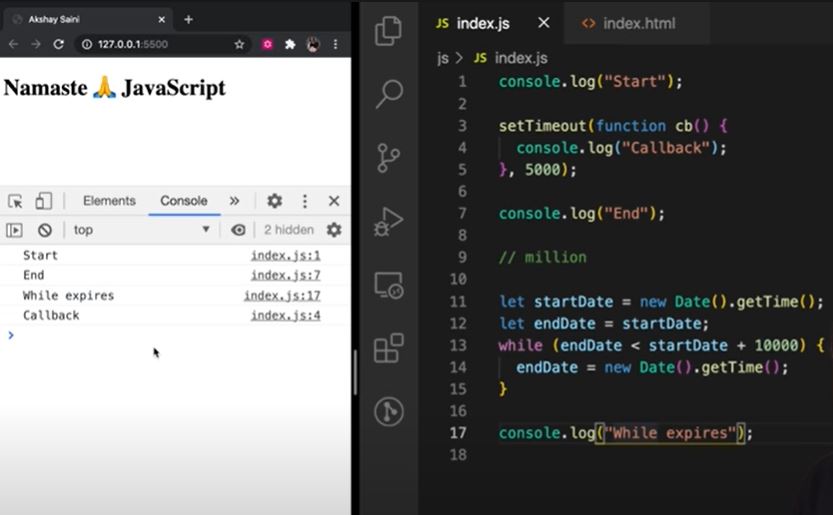
-
setTimeout guarantees that it will take at least the given timer to execute the code.
-
JS is a synchronous single threaded language. With just 1 thread it runs all pieces of code. It becomes kind of an interpreter language, and runs code very fast inside browser (no need to wait for code to be compiled) (JIT - Just in time compilation). And there are still ways to do async operations as well.
-
What if timeout = 0sec?
console.log("Start"); setTimeout(function cb() { console.log("Callback"); }, 0); console.log("End"); // Even though timer = 0s, the cb() has to go through the queue. Registers calback in webapi's env , moves to callback queue, and execute once callstack is empty. // O/p - Start End Callback // This method of putting timer = 0, can be used to defer a less imp function by a little so the more important function(here printing "End") can take place
Watch Live On Youtube below:
Episode 18 : Higher-Order Functions ft. Functional Programming
Q: What is Higher Order Function?
Ans: Higher-order functions are regular functions that take one or more functions as arguments and/or return functions as a value from it. Eg:
function x() {
console.log("Hi");
};
function y(x) {
x();
};
y(x); // Hi
// y is a higher order function
// x is a callback function
Let's try to understand how we should approach solution in interview. I have an array of radius and I have to calculate area using these radius and store in an array.
First Approach:
const radius = [1, 2, 3, 4];
const calculateArea = function(radius) {
const output = [];
for (let i = 0; i < radius.length; i++) {
output.push(Math.PI * radius[i] * radius[i]);
}
return output;
}
console.log(calculateArea(radius));
The above solution works perfectly fine but what if we have now requirement to calculate array of circumference. Code now be like
const radius = [1, 2, 3, 4];
const calculateCircumference = function(radius) {
const output = [];
for (let i = 0; i < radius.length; i++) {
output.push(2 * Math.PI * radius[i]);
}
return output;
}
console.log(calculateCircumference(radius));
But over here we are violating some principle like DRY Principle, now lets observe the better approach.
const radiusArr = [1, 2, 3, 4];
// logic to calculate area
const area = function (radius) {
return Math.PI * radius * radius;
}
// logic to calculate circumference
const circumference = function (radius) {
return 2 * Math.PI * radius;
}
const calculate = function(radiusArr, operation) {
const output = [];
for (let i = 0; i < radiusArr.length; i++) {
output.push(operation(radiusArr[i]));
}
return output;
}
console.log(calculate(radiusArr, area));
console.log(calculate(radiusArr, circumference));
// Over here calculate is HOF
// Over here we have extracted logic into separate functions. This is the beauty of functional programming.
Polyfill of map
// Over here calculate is nothing but polyfill of map function
// console.log(radiusArr.map(area)) == console.log(calculate(radiusArr, area));
***************************************************
Lets convert above calculate function as map function and try to use. So,
Array.prototype.calculate = function(operation) {
const output = [];
for (let i = 0; i < this.length; i++) {
output.push(operation(this[i]));
}
return output;
}
console.log(radiusArr.calculate(area))
Watch Live On Youtube below:
Episode 19 : map, filter & reduce
map, filter & reducer are Higher Order Functions.
Map function
It is basically used to transform a array. The map() method creates a new array with the results of calling a function for every array element.
const output = arr.map(function) // this function tells map that what transformation I want on each element of array
const arr = [5, 1, 3, 2, 6];
// Task 1: Double the array element: [10, 2, 6, 4, 12]
function double(x) {
return x * 2;
}
const doubleArr = arr.map(double); // Internally map will run double function for each element of array and create a new array and returns it.
console.log(doubleArr); // [10, 2, 6, 4, 12]
// Task 2: Triple the array element
const arr = [5, 1, 3, 2, 6];
// Transformation logic
function triple(x) {
return x * 3;
}
const tripleArr = arr.map(triple);
console.log(tripleArr); // [15, 3, 9, 6, 18]
// Task 3: Convert array elements to binary
const arr = [5, 1, 3, 2, 6];
// Transformation logic:
function binary(x) {
return x.toString(2);
}
const binaryArr = arr.map(binary);
// The above code can be rewritten as :
const binaryArr = arr.map(function binary(x) {
return x.toString(2);
}
// OR -> Arrow function
const binaryArr = arr.map((x) => x.toString(2));
So basically map function is mapping each and every value and transforming it based on given condition.
Filter function
Filter function is basically used to filter the value inside an array. The arr.filter() method is used to create a new array from a given array consisting of only those elements from the given array which satisfy a condition set by the argument method.
const array = [5, 1, 3, 2, 6];
// filter odd values
function isOdd(x) {
return x % 2;
}
const oddArr = array.filter(isOdd); // [5,1,3]
// Other way of writing the above:
const oddArr = arr.filter((x) => x % 2);
Filter function creates an array and store only those values which evaluates to true.
Reduce function
It is a function which take all the values of array and gives a single output of it. It reduces the array to give a single output.
const array = [5, 1, 3, 2, 6];
// Calculate sum of elements of array - Non functional programming way
function findSum(arr) {
let sum = 0;
for (let i = 0; i < arr.length; i++) {
sum = sum + arr[i];
}
return sum;
}
console.log(findSum(array)); // 17
// reduce function way
const sumOfElem = arr.reduce(function (accumulator, current) {
// current represent the value of array
// accumulator is used the result from element of array.
// In comparison to previous code snippet, *sum* variable is *accumulator* and *arr[i]* is *current*
accumulator = accumulator + current;
return accumulator;
}, 0); //In above example sum was initialized with 0, so over here accumulator also needs to be initialized, so the second argument to reduce function represent the initialization value.
console.log(sumOfElem); // 17
// find max inside array: Non functional programming way:
const array = [5, 1, 3, 2, 6];
function findMax(arr) {
let max = 0;
for(let i = 0; i < arr.length; i++ {
if (arr[i] > max) {
max = arr[i]
}
}
return max;
}
console.log(findMax(array)); // 6
// using reduce
const output = arr.reduce((acc, current) => {
if (current > acc ) {
acc = current;
}
return acc;
}, 0);
console.log(output); // 6
// acc is just a label which represent the accumulated value till now,
// so we can also label it as max in this case
const output = arr.reduce((max, current) => {
if (current > max) {
max= current;
}
return max;
}, 0);
console.log(output); // 6
Tricky MAP
const users = [
{ firstName: "Alok", lastName: "Raj", age: 23 },
{ firstName: "Ashish", lastName: "Kumar", age: 29 },
{ firstName: "Ankit", lastName: "Roy", age: 29 },
{ firstName: "Pranav", lastName: "Mukherjee", age: 50 },
];
// Get array of full name : ["Alok Raj", "Ashish Kumar", ...]
const fullNameArr = users.map((user) => user.firstName + " " + user.lastName);
console.log(fullNameArr); // ["Alok Raj", "Ashish Kumar", ...]
----------------------------------------------------------
// Get the count/report of how many unique people with unique age are there
// like: {29 : 2, 75 : 1, 50 : 1}
// We should use reduce, why? we want to deduce some information from the array. Basically we want to get a single object as output
const report = users.reduce((acc, curr) => {
if(acc[curr.age]) {
acc[curr.age] = ++ acc[curr.age] ;
} else {
acc[curr.age] = 1;
}
return acc; //to every time return update object
}, {})
console.log(report) // {29 : 2, 75 : 1, 50 : 1}
Function Chaining
// First name of all people whose age is less than 30
const users = [
{ firstName: "Alok", lastName: "Raj", age: 23 },
{ firstName: "Ashish", lastName: "Kumar", age: 29 },
{ firstName: "Ankit", lastName: "Roy", age: 29 },
{ firstName: "Pranav", lastName: "Mukherjee", age: 50 },
];
// function chaining
const output = users
.filter((user) => user.age < 30)
.map((user) => user.firstName);
console.log(output); // ["Alok", "Ashish", "Ankit"]
// Homework challenge: Implement the same logic using reduce
const output = users.reduce((acc, curr) => {
if (curr.age < 30) {
acc.push(curr.firstName);
}
return acc;
}, []);
console.log(output); // ["Alok", "Ashish", "Ankit"]
Watch Live On Youtube below:
Episode 20 (Season 2 : Episode 1) : Callback
-
There are 2 Parts of Callback:
- Good Part of callback - Callback are super important while writing asynchronous code in JS
- Bad Part of Callback - Using callback we can face issue:
- Callback Hell
- Inversion of control
-
Understanding of Bad part of callback is super important to learn Promise in next lecture.
💡 JavaScript is synchronous, single threaded language. It can Just do one thing at a time, it has just one call-stack and it can execute one thing at a time. Whatever code we give to Javascript will be quickly executed by Javascript engine, it does not wait.
console.log("Namaste");
console.log("JavaScript");
console.log("Season 2");
// Namaste
// JavaScript
// Season 2
// 💡 It is quickly printing because `Time, tide & Javascript waits for none.`
But what if we have to delay execution of any line, we could utilize callback, How?
console.log("Namaste");
setTimeout(function () {
console.log("JavaScript");
}, 5000);
console.log("Season 2");
// Namaste
// Season 2
// JavaScript
// 💡 Here we are delaying the execution using callback approach of setTimeout.
🛒 e-Commerce web app situation
Assume a scenario of e-Commerce web, where one user is placing order, he has added items like, shoes, pants and kurta in cart and now he is placing order. So in backend the situation could look something like this.
const cart = ["shoes", "pants", "kurta"];
// Two steps to place a order
// 1. Create a Order
// 2. Proceed to Payment
// It could look something like this:
api.createOrder();
api.proceedToPayment();
Assumption, once order is created then only we can proceed to payment, so there is a dependency. So How to manage this dependency. Callback can come as rescue, How?
api.createOrder(cart, function () {
api.proceedToPayment();
});
// 💡 Over here `createOrder` api is first creating a order then it is responsible to call `api.proceedToPayment()` as part of callback approach.
To make it a bit complicated, what if after payment is done, you have to show Order summary by calling api.showOrderSummary() and now it has dependency on api.proceedToPayment()
Now my code should look something like this:
api.createOrder(cart, function () {
api.proceedToPayment(function () {
api.showOrderSummary();
});
});
Now what if we have to update the wallet, now this will have a dependency over showOrderSummary
api.createOrder(cart, function () {
api.proceedToPayment(function () {
api.showOrderSummary(function () {
api.updateWallet();
});
});
});
// 💡 Callback Hell
When we have a large codebase and multiple apis and have dependency on each other, then we fall into callback hell. These codes are tough to maintain. These callback hell structure is also known as Pyramid of Doom.
Till this point we are comfortable with concept of callback hell but now lets discuss about Inversion of Control. It is very important to understand in order to get comfortable around the concept of promise.
💡 Inversion of control is like that you lose the control of code when we are using callback.
Let's understand with the help of example code and comments:
api.createOrder(cart, function () {
api.proceedToPayment();
});
// 💡 So over here, we are creating a order and then we are blindly trusting `createOrder` to call `proceedToPayment`.
// 💡 It is risky, as `proceedToPayment` is important part of code and we are blindly trusting `createOrder` to call it and handle it.
// 💡 When we pass a function as a callback, basically we are dependant on our parent function that it is his responsibility to run that function. This is called `inversion of control` because we are dependant on that function. What if parent function stopped working, what if it was developed by another programmer or callback runs two times or never run at all.
// 💡 In next session, we will see how we can fix such problems.
💡 Async programming in JavaScript exists because callback exits.
more at http://callbackhell.com/
Watch Live On Youtube below:
Episode 21 (Season 2 : Episode 2) : Promises
Promises are used to handle async operations in JavaScript.
We will discuss with code example that how things used to work before Promises and then how it works after Promises
Suppose, taking an example of E-Commerce
const cart = ["shoes", "pants", "kurta"];
// Below two functions are asynchronous and dependent on each other
const orderId = createOrder(cart);
proceedToPayment(orderId);
// with Callback (Before Promise)
// Below here, it is the responsibility of createOrder function to first create the order then call the callback function
createOrder(cart, function () {
proceedToPayment(orderId);
});
// Above there is the issue of `Inversion of Control`
Q: How to fix the above issue?
A: Using Promise.
Now, we will make createOrder function return a promise and we will capture that promise into a variable
Promise is nothing but we can assume it to be empty object with some data value in it, and this data value will hold whatever this createOrder function will return.
Since createOrder function is an async function and we don't know how much time will it take to finish execution.
So the moment createOrder will get executed, it will return you a undefined value. Let's say after 5 secs execution finished so now orderId is ready so, it will fill the undefined value with the orderId.
In short, When createOrder get executed, it immediately returns a promise object with undefined value. then javascript will continue to execute with other lines of code. After sometime when createOrder has finished execution and orderId is ready then that will automatically be assigned to our returned promise which was earlier undefined.
Q: Question is how we will get to know response is ready?
A: So, we will attach a callback function to the promise object using then to get triggered automatically when result is ready.
const cart = ["shoes", "pants", "kurta"];
const promiseRef = createOrder(cart);
// this promiseRef has access to `then`
// {data: undefined}
// Initially it will be undefined so below code won't trigger
// After some time, when execution has finished and promiseRef has the data then automatically the below line will get triggered.
promiseRef.then(function () {
proceedToPayment(orderId);
});
Q: How it is better than callback approach?
In Earlier solution we used to pass the function and then used to trust the function to execute the callback.
But with promise, we are attaching a callback function to a promiseObject.
There is difference between these words, passing a function and attaching a function.
Promise guarantee, it will callback the attached function once it has the fulfilled data. And it will call it only once. Just once.
Earlier we talked about promise are object with empty data but that's not entirely true, Promise are much more than that.
Now let's understand and see a real promise object.
fetch is a web-api which is utilized to make api call and it returns a promise.
We will be calling public github api to fetch data https://api.github.com/users/alok722
// We will be calling public github api to fetch data
const URL = "https://api.github.com/users/alok722";
const user = fetch(URL);
// User above will be a promise.
console.log(user); // Promise {<Pending>}
/** OBSERVATIONS:
* If we will deep dive and see, this `promise` object has 3 things
* `prototype`, `promiseState` & `promiseResult`
* & this `promiseResult` is the same data which we talked earlier as data
* & initially `promiseResult` is `undefined`
*
* `promiseResult` will store data returned from API call
* `promiseState` will tell in which state the promise is currently, initially it will be in `pending` state and later it will become `fulfilled`
*/
/**
* When above line is executed, `fetch` makes API call and return a `promise` instantly which is in `Pending` state and Javascript doesn't wait to get it `fulfilled`
* And in next line it console out the `pending promise`.
* NOTE: chrome browser has some in-consistency, the moment console happens it shows in pending state but if you will expand that it will show fulfilled because chrome updated the log when promise get fulfilled.
* Once fulfilled data is there in promiseResult and it is inside body in ReadableStream format and there is a way to extract data.
*/
Now we can attach callback to above response?
Using .then
const URL = "https://api.github.com/users/alok722";
const user = fetch(URL);
user.then(function (data) {
console.log(data);
});
// And this is how Promise is used.
// It guarantees that it could be resolved only once, either it could be `success` or `failure`
/**
A Promise is in one of these states:
pending: initial state, neither fulfilled nor rejected.
fulfilled: meaning that the operation was completed successfully.
rejected: meaning that the operation failed.
*/
💡Promise Object are immutable.
-> Once promise is fulfilled and we have data we can pass here and there and we don't have to worry that someone can mutate that data. So over above we can't directly mutate user promise object, we will have to use .then
Interview Guide
💡What is Promise?
-> Promise object is a placeholder for certain period of time until we receive value from asynchronous operation.
-> A container for a future value.
-> A Promise is an object representing the eventual completion or failure of an asynchronous operation.
We are now done solving one issue of callback i.e. Inversion of Control
But there is one more issue, callback hell...
// Callback Hell Example
createOrder(cart, function (orderId) {
proceedToPayment(orderId, function (paymentInf) {
showOrderSummary(paymentInf, function (balance) {
updateWalletBalance(balance);
});
});
});
// And now above code is expanding horizontally and this is called pyramid of doom.
// Callback hell is ugly and hard to maintain.
// 💡 Promise fixes this issue too using `Promise Chaining`
// Example Below is a Promise Chaining
createOrder(cart)
.then(function (orderId) {
proceedToPayment(orderId);
})
.then(function (paymentInf) {
showOrderSummary(paymentInf);
})
.then(function (balance) {
updateWalletBalance(balance);
});
// ⚠️ Common PitFall
// We forget to return promise in Promise Chaining
// The idea is promise/data returned from one .then become data for next .then
// So,
createOrder(cart)
.then(function (orderId) {
return proceedToPayment(orderId);
})
.then(function (paymentInf) {
return showOrderSummary(paymentInf);
})
.then(function (balance) {
return updateWalletBalance(balance);
});
// To improve readability you can use arrow function instead of regular function
Watch Live On Youtube below:
Episode 22 (Season 2 : Episode 3) : Creating a Promise, Chaining & Error Handling
const cart = ["shoes", "pants", "kurta"];
// Consumer part of promise
const promise = createOrder(cart); // orderId
// Our expectation is above function is going to return me a promise.
promise.then(function (orderId) {
proceedToPayment(orderId);
});
// Above snippet we have observed in our previous lecture itself.
// Now we will see, how createOrder is implemented so that it is returning a promise
// In short we will see, "How we can create Promise" and then return it.
// Producer part of Promise
function createOrder(cart) {
// JS provides a Promise constructor through which we can create promise
// It accepts a callback function with two parameter `resolve` & `reject`
const promise = new Promise(function (resolve, reject) {
// What is this `resolve` and `reject`?
// These are function which are passed by javascript to us in order to handle success and failure of function call.
// Now we will write logic to `createOrder`
/** Mock logic steps
* 1. validateCart
* 2. Insert in DB and get an orderId
*/
// We are assuming in real world scenario, validateCart would be defined
if (!validateCart(cart)) {
// If cart not valid, reject the promise
const err = new Error("Cart is not Valid");
reject(err);
}
const orderId = "12345"; // We got this id by calling to db (Assumption)
if (orderId) {
// Success scenario
resolve(orderId);
}
});
return promise;
}
Over above, if your validateCart is returning true, so the above promise will be resolved (success),
const cart = ["shoes", "pants", "kurta"];
const promise = createOrder(cart); // orderId
// ❓ What will be printed in below line?
// It prints Promise {<pending>}, but why?
// Because above createOrder is going to take sometime to get resolved, so pending state. But once the promise is resolved, `.then` would be executed for callback.
console.log(promise);
promise.then(function (orderId) {
proceedToPayment(orderId);
});
function createOrder(cart) {
const promise = new Promise(function (resolve, reject) {
if (!validateCart(cart)) {
const err = new Error("Cart is not Valid");
reject(err);
}
const orderId = "12345";
if (orderId) {
resolve(orderId);
}
});
return promise;
}
Now let's see if there was some error and we are rejecting the promise, how we could catch that?
-> Using .catch
const cart = ["shoes", "pants", "kurta"];
const promise = createOrder(cart); // orderId
// Here we are consuming Promise and will try to catch promise error
promise
.then(function (orderId) {
// ✅ success aka resolved promise handling
proceedToPayment(orderId);
})
.catch(function (err) {
// ⚠️ failure aka reject handling
console.log(err);
});
// Here we are creating Promise
function createOrder(cart) {
const promise = new Promise(function (resolve, reject) {
// Assume below `validateCart` return false then the promise will be rejected
// And then our browser is going to throw the error.
if (!validateCart(cart)) {
const err = new Error("Cart is not Valid");
reject(err);
}
const orderId = "12345";
if (orderId) {
resolve(orderId);
}
});
return promise;
}
Now, Let's understand the concept of Promise Chaining
-> for this we will assume after createOrder we have to invoke proceedToPayment
-> In promise chaining, whatever is returned from first .then become data for next .then and so on...
-> At any point of promise chaining, if promise is rejected, the execution will fallback to .catch and others promise won't run.
const cart = ["shoes", "pants", "kurta"];
createOrder(cart)
.then(function (orderId) {
// ✅ success aka resolved promise handling
proceedToPayment(orderId);
return orderId;
})
.then(function (orderId) {
// Promise chaining
// 💡 we will make sure that `proceedToPayment` returns a promise too
return proceedToPayment(orderId);
})
.then(function (paymentInfo) {
// from above, `proceedToPayment` is returning a promise so we can consume using `.then`
console.log(paymentInfo);
})
.catch(function (err) {
// ⚠️ failure aka reject handling
console.log(err);
});
// Here we are creating Promise
function createOrder(cart) {
const promise = new Promise(function (resolve, reject) {
// Assume below `validateCart` return false then the promise will be rejected
// And then our browser is going to throw the error.
if (!validateCart(cart)) {
const err = new Error("Cart is not Valid");
reject(err);
}
const orderId = "12345";
if (orderId) {
resolve(orderId);
}
});
return promise;
}
function proceedToPayment(cart) {
return new Promise(function (resolve, reject) {
// For time being, we are simply `resolving` promise
resolve("Payment Successful");
});
}
Q: What if we want to continue execution even if any of my promise is failing, how to achieve this?
-> By placing the .catch block at some level after which we are not concerned with failure.
-> There could be multiple .catch too.
Eg:
createOrder(cart)
.then(function (orderId) {
// ✅ success aka resolved promise handling
proceedToPayment(orderId);
return orderId;
})
.catch(function (err) {
// ⚠️ Whatever fails below it, catch wont care
// this block is responsible for code block above it.
console.log(err);
});
.then(function (orderId) {
// Promise chaining
// 💡 we will make sure that `proceedToPayment` returns a promise too
return proceedToPayment(orderId);
})
.then(function (paymentInfo) {
// from above, `proceedToPayment` is returning a promise so we can consume using `.then`
console.log(paymentInfo);
})
Watch Live On Youtube below:





















